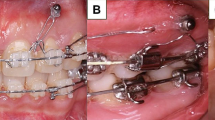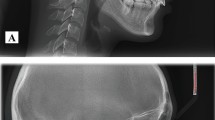Abstract
Objectives
The location of the maxillary sinus significantly affects the orthodontic treatment, particularly when temporary anchorage devices (TADs) are taking place. The current study aims to evaluate the maxillary sinus size and location in a skeletal class II population.
Materials and methods
The pre-orthodontic treatment CBCT images of the skeletal class II population were selected. The sinus’s volumetric size, height, width, and depth were measured and compared among different skeletal vertical patterns and between genders. In addition, the height and width of the alveolar bone surrounding the maxillary sinus floor were quantified in the same manner.
Results
Patients who displayed a high-angle skeletal pattern had significantly greater maxillary sinus dimensions, shorter vertical distance between the maxillary sinus floor and the alveolar bone crest, and thinner alveolar bone surrounding the maxillary sinus. Meanwhile, the maxillary sinus dimension measurements were positively correlated with the SN-MP angle in both genders but only correlated with ANB angle in females. On the other hand, the vertical distance between the maxillary sinus floor and the alveolar bone crest was negatively correlated with the SN-MP angle in males but the ANB angle in females.
Conclusions
In the skeletal class II population, the high-angle patients faced a higher risk of maxillary sinus perforations by TADs. In addition, gender-related variations were noticed warranting clinical attention, as males have a higher potential for maxillary sinus penetration from TAD placement than females.
Clinical relevance
Maxillary posterior alveolar TADs are often prescribed to achieve the distalization of maxillary posterior teeth in class II patients. The current study provided more insight into the “safe zone” for TAD placement related to the maxillary sinus.











Similar content being viewed by others
Data availability
All data generated or analyzed during this study are included in this published article.
References
Baker EW, Schuenke M, Schulte E (2011) Head and neck anatomy for dental medicine. Thieme
Jacobsen PL, Casagrande AM (2003) Sinusitis as a source of dental pain. Dent Today 22(9):110–113
Malina-Altzinger J, Damerau G, Gratz KW, Stadlinger PD (2015) Evaluation of the maxillary sinus in panoramic radiography-a comparative study. Int J Implant Dent 1(1):17. https://doi.org/10.1186/s40729-015-0015-1
Chirila L, Rotaru C, Filipov I, Sandulescu M (2016) Management of acute maxillary sinusitis after sinus bone grafting procedures with simultaneous dental implants placement - a retrospective study. BMC Infect Dis 16(Suppl 1):94. https://doi.org/10.1186/s12879-016-1398-1
Sun W, Xia K, Huang X, Cen X, Liu Q, Liu J (2018) Knowledge of orthodontic tooth movement through the maxillary sinus: a systematic review. BMC Oral Health 18(1):91. https://doi.org/10.1186/s12903-018-0551-1
Matsumoto K, Sherrill-Mix S, Boucher N, Tanna N (2020) A cone-beam computed tomographic evaluation of alveolar bone dimensional changes and the periodontal limits of mandibular incisor advancement in skeletal class II patients. Angle Orthod 90(3):330–338. https://doi.org/10.2319/080219-510.1
Kapetanovic A, Theodorou CI, Berge SJ, Schols J, Xi T (2021) Efficacy of Miniscrew-Assisted Rapid Palatal Expansion (MARPE) in late adolescents and adults: a systematic review and meta-analysis. Eur J Orthod. https://doi.org/10.1093/ejo/cjab005
Xia K, Wang J, Yu L, Sun W, Huang X, Zhao Z et al (2021) Dentofacial characteristics and age in association with incisor bony support in adult female patients with bimaxillary dentoalveolar protrusion. Orthod Craniofac Res. https://doi.org/10.1111/ocr.12484
Horiuchi A, Hotokezaka H, Kobayashi K (1998) Correlation between cortical plate proximity and apical root resorption. Am J Orthod Dentofacial Orthop 114(3):311–318. https://doi.org/10.1016/s0889-5406(98)70214-8
Park JH (2020) Temporary anchorage devices in clinical orthodontics. Wiley
Kravitz ND, Kusnoto B, Tsay TP, Hohlt WF (2007) The use of temporary anchorage devices for molar intrusion. J Am Dent Assoc 138(1):56–64. https://doi.org/10.14219/jada.archive.2007.0021
Shinohara A, Motoyoshi M, Uchida Y, Shimizu N (2013) Root proximity and inclination of orthodontic mini-implants after placement: cone-beam computed tomography evaluation. Am J Orthod Dentofacial Orthop 144(1):50–56. https://doi.org/10.1016/j.ajodo.2013.02.021
Jia X, Chen X, Huang X (2018) Influence of orthodontic mini-implant penetration of the maxillary sinus in the infrazygomatic crest region. Am J Orthod Dentofacial Orthop 153(5):656–661. https://doi.org/10.1016/j.ajodo.2017.08.021
Lopes LJ, Gamba TO, Bertinato JV, Freitas DQ (2016) Comparison of panoramic radiography and CBCT to identify maxillary posterior roots invading the maxillary sinus. Dentomaxillofac Radiol 45(6):20160043. https://doi.org/10.1259/dmfr.20160043
Miyazawa K, Shibata M, Tabuchi M, Kawaguchi M, Shimura N, Goto S (2021) Optimal sites for orthodontic anchor screw placement using panoramic images: risk of maxillary sinus perforation and contact with adjacent tooth roots during screw placement. Prog Orthod 22(1):46. https://doi.org/10.1186/s40510-021-00393-1
Li C, Lin L, Zheng Z, Chung CH (2021) A user-friendly protocol for mandibular segmentation of CBCT images for superimposition and internal structure analysis. J Clin Med 10(1). https://doi.org/10.3390/jcm10010127
Li C, Teixeira H, Tanna N, Zheng Z, Chen SHY, Zou M, et al (2021) The reliability of two- and three-dimensional cephalometric measurements: a CBCT study. Diagnostics (Basel). 11(12). https://doi.org/10.3390/diagnostics11122292.
Cao L, Li J, Yang C, Hu B, Zhang X, Sun J (2019) High-efficiency treatment with the use of traditional anchorage control for a patient with class II malocclusion and severe overjet. Am J Orthod Dentofacial Orthop 155(3):411–420. https://doi.org/10.1016/j.ajodo.2017.08.030
Li X, Wang H, Li S, Bai Y (2019) Treatment of a class II division 1 malocclusion with the combination of a myofunctional trainer and fixed appliances. Am J Orthod Dentofacial Orthop 156(4):545–554. https://doi.org/10.1016/j.ajodo.2018.04.032
Song G, Chen H, Xu T (2018) Nonsurgical treatment of Brodie bite assisted by 3-dimensional planning and assessment. Am J Orthod Dentofacial Orthop 154(3):421–432. https://doi.org/10.1016/j.ajodo.2017.05.039
Ryu J, Choi SH, Cha JY, Lee KJ, Hwang CJ (2016) Retrospective study of maxillary sinus dimensions and pneumatization in adult patients with an anterior open bite. Am J Orthod Dentofacial Orthop 150(5):796–801. https://doi.org/10.1016/j.ajodo.2016.03.032
Benjamin DJ, Berger JO, Johannesson M, Nosek BA, Wagenmakers EJ, Berk R et al (2018) Redefine statistical significance. Nat Hum Behav 2(1):6–10. https://doi.org/10.1038/s41562-017-0189-z
Kau CH, English JD, Muller-Delgardo MG, Hamid H, Ellis RK, Winklemann S (2010) Retrospective cone-beam computed tomography evaluation of temporary anchorage devices. Am J Orthod Dentofacial Orthop 137(2):166 e1–5; discussion -7. https://doi.org/10.1016/j.ajodo.2009.06.019.
Maspero C, Farronato M, Bellincioni F, Annibale A, Machetti J, Abate A, et al (2020) Three-dimensional evaluation of maxillary sinus changes in growing subjects: a retrospective cross-sectional study. Materials (Basel) 13(4). https://doi.org/10.3390/ma13041007
Oktay H (1992) The study of the maxillary sinus areas in different orthodontic malocclusions. Am J Orthod Dentofacial Orthop 102(2):143–145. https://doi.org/10.1016/0889-5406(92)70026-7
Endo T, Abe R, Kuroki H, Kojima K, Oka K, Shimooka S (2010) Cephalometric evaluation of maxillary sinus sizes in different malocclusion classes. Odontology 98(1):65–72. https://doi.org/10.1007/s10266-009-0108-5
Kula K, Ghoneima A (2020) Cephalometry in orthodontics: 2D and 3D. Quintessence Publishing Company
Kosumarl W, Patanaporn V, Jotikasthira D, Janhom A (2017) Distances from the root apices of posterior teeth to the maxillary sinus and mandibular canal in patients with skeletal open bite: a cone-beam computed tomography study. Imaging Sci Dent 47(3):157–164. https://doi.org/10.5624/isd.2017.47.3.157
Aktuna Belgin C, Colak M, Adiguzel O, Akkus Z, Orhan K (2019) Three-dimensional evaluation of maxillary sinus volume in different age and sex groups using CBCT. Eur Arch Otorhinolaryngol 276(5):1493–1499. https://doi.org/10.1007/s00405-019-05383-y
Saccucci M, Cipriani F, Carderi S, Di Carlo G, D’Attilio M, Rodolfino D et al (2015) Gender assessment through three-dimensional analysis of maxillary sinuses by means of cone beam computed tomography. Eur Rev Med Pharmacol Sci 19(2):185–193
Gulec M, Tassoker M, Magat G, Lale B, Ozcan S, Orhan K (2020) Three-dimensional volumetric analysis of the maxillary sinus: a cone-beam computed tomography study. Folia Morphol (Warsz) 79(3):557–562. https://doi.org/10.5603/FM.a2019.0106
Ichinohe M, Motoyoshi M, Inaba M, Uchida Y, Kaneko M, Matsuike R et al (2019) Risk factors for failure of orthodontic mini-screws placed in the median palate. J Oral Sci 61(1):13–18. https://doi.org/10.2334/josnusd.17-0377
Funding
This study was supported by the American Association of Orthodontists Foundation (AAOF) Orthodontic Faculty Development Fellowship Award, American Association of Orthodontists (AAO) Full-Time Faculty Fellowship Award, University of Pennsylvania School of Dental Medicine Joseph and Josephine Rabinowitz Award for Excellence in Research, and the J. Henry O’Hern Jr. Pilot Grant from the Department of Orthodontics, University of Pennsylvania School of Dental Medicine for Chenshuang Li.
Author information
Authors and Affiliations
Contributions
Conceptualization: Chenshuang Li; methodology, Chenshuang Li and Zhong Zheng; software: Chenshuang Li; validation: Abby Syverson; formal analysis: Abby Syverson, Evgenii Proskurnin, and Chenshuang Li; resources: Min Zou; data curation: Chenshuang Li; writing—original draft preparation: Abby Syverson; writing—review and editing: Chenshuang Li, Zhong Zheng, Evgenii Proskurnin, Chun-Hsi Chung, and Min Zou; supervision: Chenshuang Li; project administration: Chenshuang Li; funding acquisition: Chenshuang Li. All authors have read and agreed to the published version of the manuscript.
Corresponding authors
Ethics declarations
Ethics approval
The study was conducted according to the guidelines of the Declaration of Helsinki and approved by the Institutional Review Board of the University of Pennsylvania (protocol number: 843465; date of approval: 30th June, 2020) and by the Institutional Review Board of College of Stomatology, Xi’an Jiaotong University (protocol number: xjkqll[2020]NO.014; date of approval: 26th August, 2020).
Consent to participate
Patient consent was waived because the CBCT scans for this study were derived from the pre-existing clinical database of pre-orthodontic treatment records. No additional radiologic images were taken for the current study, and no personal identification information was included in the current study.
Conflict of interest
The authors declare no competing interests.
Additional information
Publisher’s note
Springer Nature remains neutral with regard to jurisdictional claims in published maps and institutional affiliations.
Rights and permissions
About this article
Cite this article
Syverson, A., Li, C., Zheng, Z. et al. Maxillary sinus dimensions in skeletal class II population with different vertical skeletal patterns. Clin Oral Invest 26, 5045–5060 (2022). https://doi.org/10.1007/s00784-022-04476-z
Received:
Accepted:
Published:
Issue Date:
DOI: https://doi.org/10.1007/s00784-022-04476-z




